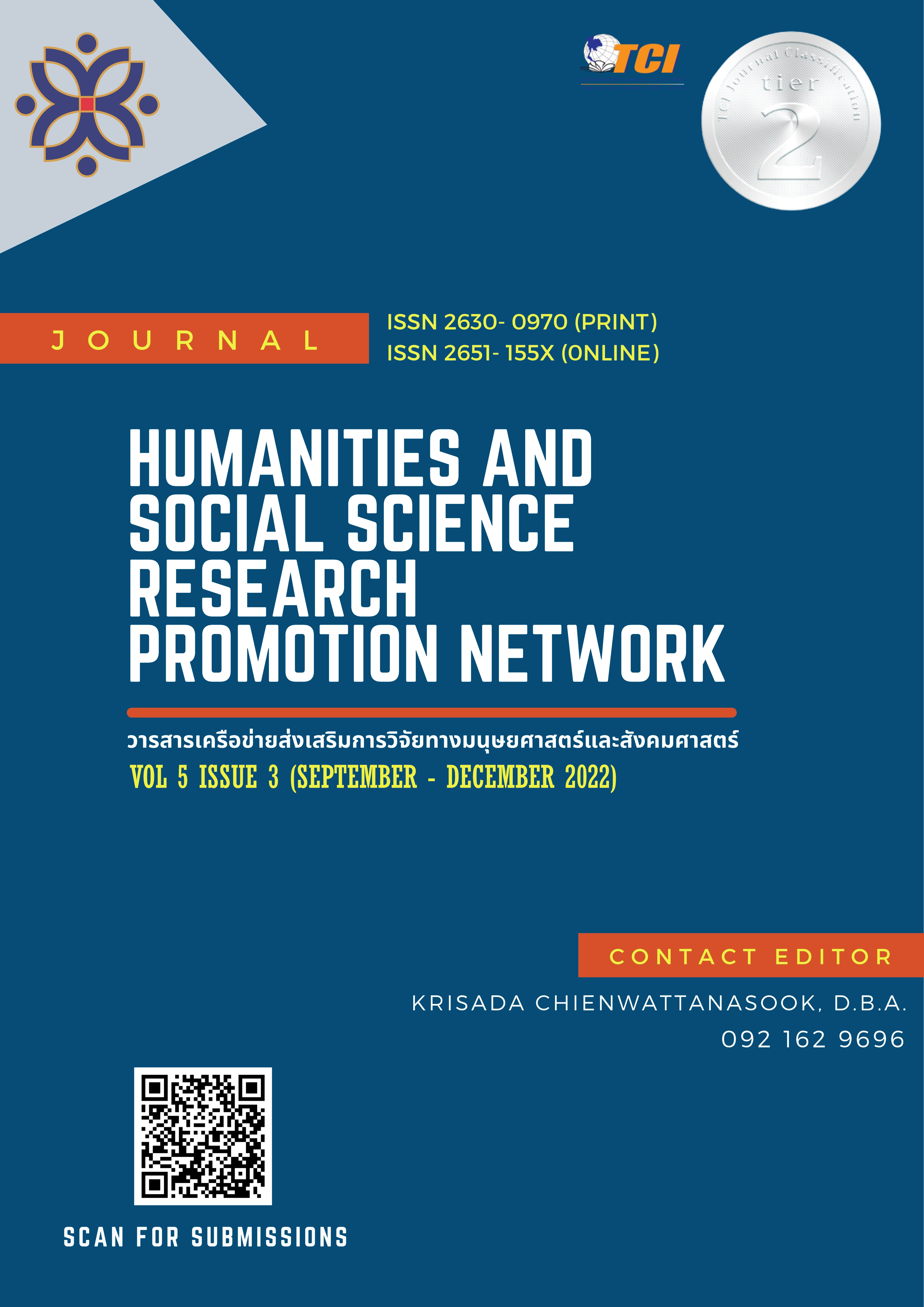ประสิทธิภาพของเกมแฟลชการ์ดสำหรับผู้เรียนภาษาที่สอง
คำสำคัญ:
การตอบสนองทางกายภาพโดยรวม , ภาษาอังกฤษเป็นภาษาต่างประเทศ , การสอนแบบโดยนัย , การสอนแบบโดยตรงบทคัดย่อ
ปัจจุบันบัตรคำศัพท์ได้กลายเป็นแหล่งข้อมูลที่มีประโยชน์มากที่สุดในการเรียนรู้ภาษาที่สอง ไม่เพียงแค่ช่วยให้ผู้เรียนภาษาที่สองได้สามารถจดจำคำศัพท์ผ่านภาพเท่านั้น แต่ยังช่วยสร้างสภาพแวดล้อมในการเรียนรู้ที่เป็นเชิงบวกอีกด้วย บทความนี้กล่าวถึงการใช้เกมแฟลชการ์ดเพื่อเพิ่มการจดจำคำศัพท์ที่เป็นเป้าหมายในกลุ่มนักเรียนอนุบาลของไทย เมื่อเรียนภาษาอังกฤษในบริบทของ EFL (ภาษาอังกฤษเป็นภาษาต่างประเทศ) ซึ่งมีการกล่าวถึงการใช้วิธีการสอนทั้งแบบโดยอ้อมและโดยตรง (โดยนัยและชัดเจน) เมื่อมีการสอนคำศัพท์ใหม่ และพบว่าวิธีการสอนแบบโดยอ้อมจะช่วยให้คงคำศัพท์ได้ดีกว่า แต่การผสมผสานของทั้งสองวิธีมีผลในระยะที่ยาวนานขึ้นในการจดจำคำศัพท์ กรณีศึกษาครั้งนี้ ประกอบด้วยสองชั้นเรียน K2 (อายุสี่ขวบ) โดยมีจำนวนนักเรียนสิบหกคนในแต่ละชั้นเรียน ใช้ระยะเวลาสองสัปดาห์ ซึ่งพบว่า ทั้งสองชั้นเรียนเรียนรู้คำศัพท์เป้าหมายโดยใช้แฟลชการ์ดที่มีการให้คำแนะนำทั้งโดยตรงและโดยอ้อม แต่มีเพียงหนึ่งในชั้นเรียนเท่านั้นที่เข้าร่วมเกมแฟลชการ์ดเป็นพิเศษ จำนวนสี่ครั้งต่อสัปดาห์ โดยเกมสุดท้ายของแต่ละสัปดาห์จะมีรางวัลเพิ่มเข้ามาสำหรับเวลาที่ใช้ทำคะแนนได้เร็วที่สุดในเกม การศึกษาใช้การทดสอบก่อนเรียนและหลังการทดสอบ โดยผลการทดสอบหลังเรียนแสดงให้เห็นว่าชั้นเรียนที่มีเกมแฟลชการ์ด มีการจดจำคำศัพท์เป้าหมายไว้สูงกว่าชั้นเรียนที่ไม่ได้เข้าร่วมเล่นเกม ผลการวิจัย พบว่า การใช้เกมแฟลชการ์ดช่วยให้จดจำคำศัพท์ได้ดีขึ้น แต่ได้มีการกล่าวถึงปัจจัยอื่นไว้ในส่วนอภิปรายผลและจากการที่นักเรียนได้รับการสอนโดยผู้วิจัยมาระยะหนึ่งแล้วนั้นอาจส่งผลต่อผลลัพธ์ที่ได้จากการศึกษา นอกจากนี้มีการทดลองใช้คำศัพท์เพียงแปดคำในการวิจัยนี้ อาจจะเป็นคำที่นักเรียนรู้จักหรือคุ้นเคยอยู่แล้ว ดังนั้นจึงควรทำการศึกษาซ้ำกับครูหลาย ๆ คนและใช้คำศัพท์ที่นักเรียนไม่คุ้นเคย
เอกสารอ้างอิง
Ahmadian, M. J. (2020). Explicit and implicit instruction of refusal strategies: Does working memory capacity play a role?. Language Teaching Research, 24(2), 163-188.
Ahmed, Y., Miciak, J., Taylor, W. P., & Francis, D. J. (2022). Structure Altering Effects of a Multicomponent Reading Intervention: An Application of the Direct and Inferential Mediation (DIME) Model of Reading Comprehension in Upper Elementary Grades. Journal of learning disabilities, 55(1), 58-78.
Bakhodirovna, K. F. (2022). The Importance of TPR (Total Physical Response) Method in Teaching English for beginners. Eurasian Journal of Learning and Academic Teaching, 8, 156-158.
Blair, S. S. (2022). The social turn in second language acquisition. In The Social Turn in Second Language Acquisition. Edinburgh: Edinburgh University Press.
Clément, R., Gardner, R. C., & Smythe, P. C. (1977). Motivational variables in second language acquisition: A study of Francophones learning English. Canadian Journal of Behavioural Science / Revue canadienne des sciences du comportement, 9(2), 123-133.
Cook, C. C. H., & Powell, A. (2022). Spirituality and psychiatry (2nd Edition). Cambridge: Cambridge University Press.
Dewi, N. L., & Fatmawati, A. (2022). The Implementation of Total Physical Response (Tpr) Method to Teach Vocabulary in E-Learning. Jurnal Pendidikan Bahasa Inggris Proficiency, 4(1), 29-38.
Dolgunsöz, E. (2015). Measuring Attention in Second Language Reading Using Eye-tracking: The Case of the Noticing Hypothesis. Journal of Eye Movement Research, 8(5), 1-18.
Godfroid, A. (2019). Eye tracking in second language acquisition and bilingualism: A research synthesis and methodological guide. New York: Routledge.
Godfroid, A., Boers, F., & Housen, A. (2013). An Eye for Words. Gauging the role of attention in L2 vocabulary acquisition by means of eye tracking. Studies in Second Language Acquisition, 35(3), 483-517.
Gumiandari, S. (2021). Introducing English to Early Childhood through Singing with the Total Physical Response Method. Acitya: Journal of Teaching and Education, 3(1), 86-94.
Johnson, E. (2022). Fo (u) r Friends: The Social, Emotional, and Academic Effects of an Extracurricular Program for Secondary Newcomer Students. (Master’ thesis, Hamline University, The United States of America).
Li, J. (2022). A systematic review of video games for second language acquisition. Research Anthology on Developments in Gamification and Game-Based Learning, 1345-1371.
Lopez Vera, A. (2022). Implicit Instruction of Direct and Indirect Object Pronouns in Spanish through Technology-Mediated Task-Based Language Teaching. (Doctoral dissertation, UC Santa Barbara).
Pinter, G. (2022). Inflation and Uncertainty: A Note. Economics Letters, 22, 110917.
Ravem, R. (1974). Language acquisition in a second language environment. Error analysis: Perspectives on second language acquisition, 124-133. Longman London.
Ryan. (2022). The Indirect Method Of Teaching English. Retrieved from https://www.englishraven.com/What-Is-Indirect-Method-Of-Teaching-English/
Schmidt, R. (2010). Attention, awareness, and individual differences in language learning. In W. M. Chan, S. Chi, K. N. Cin, J. Istanto, M. Nagami, J. W. Sew, T. Suthiwan, & I. Walker, Proceedings of CLaSIC 2010, Singapore, December 2-4, 721-737). Singapore: National University of Singapore, Centre for Language Studies.
Suikkanen, S. (2022). Home-Based Physical Exercise Among Older Adults with Signs of Frailty: Emphasis on Days Lived at Home, Utilization of Social and Health Care Services, Quality of Life, Physical Functioning, and Severity of Frailty. JYU dissertations. University of Jyväskylä.
Taimalu, M., & Luik, P. (2019). The impact of beliefs and knowledge on the integration of technology among teacher educators: A path analysis. Teaching and Teacher Education, 79(1), 101-110.
Toth, P. D. (2022). Introduction: Investigating explicit L2 grammar instruction through multiple theoretical and methodological lenses. Language Learning, 72(S1), 5-40.
Vasu, K. A. P., Mei Fung, Y., Nimehchisalem, V., & Md Rashid, S. (2022). Self-regulated learning development in undergraduate ESL writing classrooms: Teacher feedback versus self-assessment. RELC Journal, 53(3), 612-626.
Walldén, R. (2022). Focusing on content or strategies? Enactment of reading strategies in discussions about science texts. Classroom Discourse, 13(4), 407-424.
Yeldham, M., & Choy, V. (2022). The effectiveness of direct articulatory–abdominal pronunciation instruction for English learners in Hong Kong. Language, Culture and Curriculum, 35(2), 184-199.
ดาวน์โหลด
เผยแพร่แล้ว
รูปแบบการอ้างอิง
ฉบับ
ประเภทบทความ
สัญญาอนุญาต
ลิขสิทธิ์ (c) 2022 เดวิด แพตทิสัน, ศศิวรรณ อินทรสกุล, อกิล ออกัสติน

อนุญาตภายใต้เงื่อนไข Creative Commons Attribution-NonCommercial-NoDerivatives 4.0 International License.
บทความที่ได้รับการตีพิมพ์เป็นลิขสิทธิ์ของ ผู้เขียน
ทัศนะและความคิดเห็นที่ปรากฏในบทความในวารสารเครือข่ายส่งเสริมการวิจัยทางมนุษยศาสตร์และสังคมศาสตร์จะถือเป็นความรับผิดชอบของผู้เขียนบทความนั้น และไม่ถือเป็นทัศนะและความรับผิดชอบของกองบรรณาธิการ








